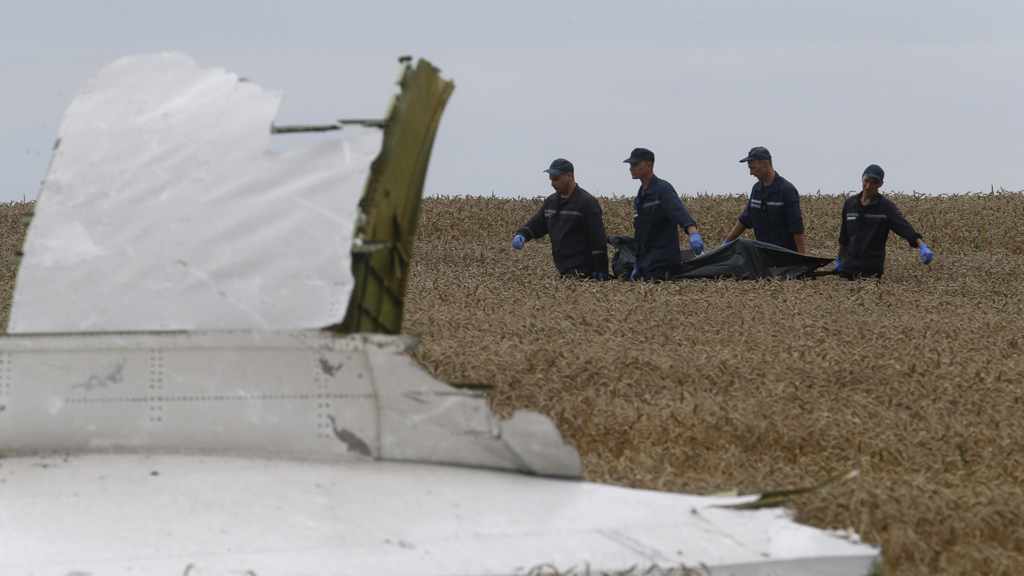Has MH17 report done what it set out to do?
Dutch crash investigators issue the preliminary report into the crash of MH17 – but does it really tell us what happened in Ukraine?

The wreckage of Malaysia Airlines flight MH17, which fell from the sky in Ukraine in July, was “consistent with the damage that would be expected from a large number of high-energy objects that penetrated the aircraft from outside”, said Dutch crash investigators. A total of 298 people, including 10 Britons, died in the 17 July incident, which came only months after another Malaysia Airlines Boeing 777 disappeared over the Indian Ocean.
What follows below is a summary of how the Dutch Safety Board (DSB) have updated aims of the investigation on their website – from the moment MH17 crashed until the report was published on Tuesday.
18 July
The DSB travels to Ukraine to take part in the international investigation into the disaster. According to international (ICAO) regulations, the state in which the crash took place is responsible for taking the lead in investigating the circumstances of the incident. The international investigation is likely to direct its full focus on the cause of the crash, how it unfolded, the decision-making processes around flight routes, and the availability of passenger lists.
23 July
The DSB takes over formal responsibility for the air crash investigation from Ukraine. The first priorities will be to gather information from the crash site, analyse the black boxes and coordinate the international team. Ultimately, the air crash investigation should offer victims families and the international community a clear and comprehensive overview of the causes and course of the crash.
The investigators have not yet been able to visit the site of the crash and conduct their investigation under safe conditions. The DSB’s investigation will focus on ascertaining facts, rather than apportioning blame. An international team of investigators has conducted a thorough examination of the cockpit voice recorder – the cockpit voice recorder was damaged but the memory module was intact.
24 July
The DSB is given permission to move the wreckage from the crash site in order to be able to salvage the remaining victims. The DSB considers it of the utmost importance that as many victims as possible can be returned to the Netherlands so that they can be identified and returned to their next of kin.
25 July
In the next few days, investigators from the international team investigating the cause of the crash will set out on several missions to the scene of the disaster. The investigation on the basis of other sources, such as photographs, satellite images and the data recorders (black boxes) will also continue.
The missions to the disaster area will focus on verifying the information already obtained from other sources, searching for possible new information and seizing materials that could be relevant to the investigation, such as particular pieces of the wreckage.
11 August
In recent weeks, an international team of some 25 aircraft accident investigators has collected as much investigation information as possible in Ukraine. The report will contain the first factual findings arising from the investigation based on various sources, such as the cockpit voice recorder and the flight data recorder, air traffic control data, and radar and satellite images. Since the DSB took the charge of the investigation, no new opportunity has arisen for the team to visit the crash site.
21 August
The DSB is unable to visit the crash site because the safety of the investigators cannot be guaranteed. The Dutch government believes that people investigating the causes of the crash will be at greater risk than forensic investigators, next of kin or journalists. In this respect, the safety of others at the crash site is also being taken into account. Moreover, recovering the victims’ bodies and searching for personal belongings has top priority.
Read more on what happened to Malaysia Airlines flight MH17
What the report says
- The report says the damage was caused by numerous objects hitting the plane from the outside. There are no indications that the MH17 crash was caused by a technical fault or by actions of the crew. The cockpit voice recorder, the flight data recorder and data from air traffic control all suggest that flight MH17 proceeded as normal until 13:20:03 (UTC), after which it ended abruptly.
- A full listening of communications among the crew members in the cockpit recorded on the cockpit voice recorder revealed no signs of any technical faults or an emergency situation. Neither were any warning tones heard in the cockpit that might have pointed to technical problems. The flight data recorder registered no aircraft system warnings, and aircraft engine parameters were consistent with normal operation during the flight. The radio communications with Ukrainian air traffic control confirm that no emergency call was made by the cockpit crew.
- The pattern of wreckage on the ground suggests that the aircraft split into pieces during flight (an in-flight break up). Based on the available maintenance history, the airplane was airworthy when it took off from Amsterdam and there were no known technical problems. The aircraft was manned by a qualified and experienced crew.
- As yet it has not been possible to conduct a detailed study of the wreckage. However, the available images show that the pieces of wreckage were pierced in numerous places. The pattern of damage to the aircraft fuselage and the cockpit is consistent with that which may be expected from a large number of high-energy objects that penetrated the aircraft from outside.
- It is likely that this damage resulted in a loss of structural integrity of the aircraft, leading to an in-flight break up. This also explains the abrupt end to the data registration on the recorders, the simultaneous loss of contact with air traffic control, and the aircraft’s disappearance from radar.